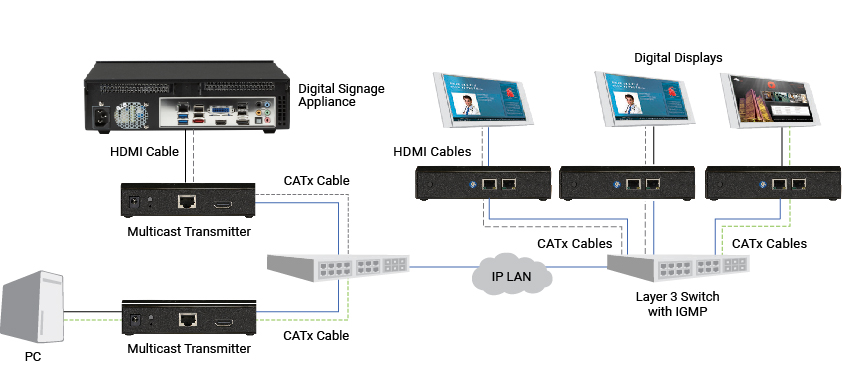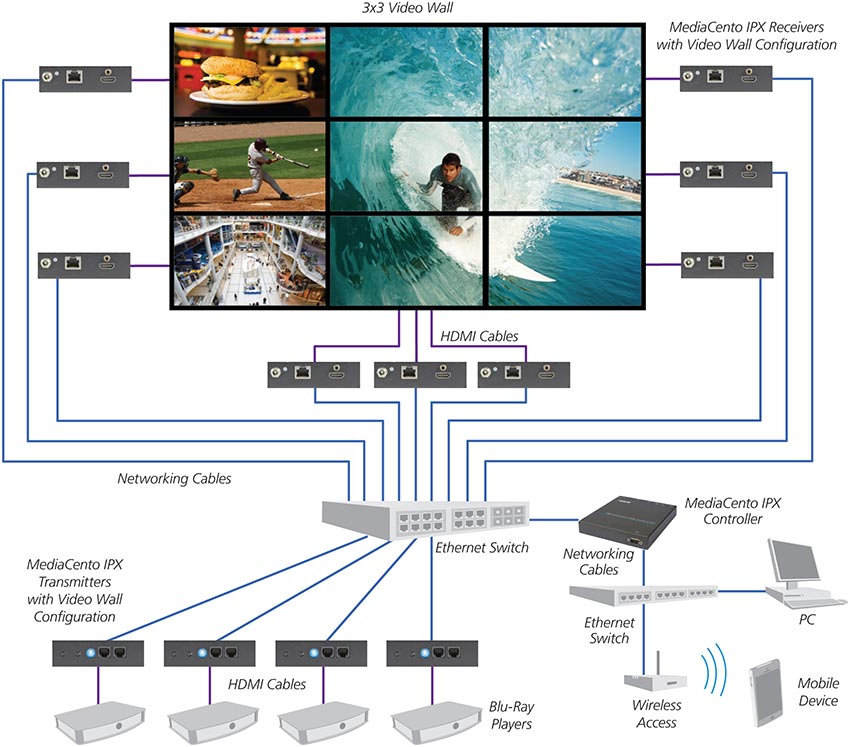Professional Video-over-IP Distribution Basics
What Is Video over IP and How Does It Work?
Video over IP is a widely used method of delivering video content to an audience over a local or wide area network where media inputs are deconstructed into different streams and then sent over an IP network as individual data packets. Meaning users can watch real-time video and audio content, similar to watching a television broadcast. In the context of media production networks, video over IP can be perceived as a newer alternative to SDI broadcasting which has been a standard for many years.
Video-over-IP Use Cases and Applications
1. Multicasting Video Streams over IP Networks
IP multicasting allows the distribution of video and audio to any supported number of displays on a network. In digital signage, for example, a single content source can deliver multimedia to hundreds of displays through one AV transmitter with no need to run dedicated video links from a back room to displays in lobbies. For easy integration, consider using transmitters and receivers that install directly into the existing LAN infrastructure.
Use IP video multicast switches and set the transmitter and receiver to the same multicast or unicast channel so that all IP multicasting settings are automatically configured. Just connect your source, your display(s) and a network switch.
2. Video Wall Management over IP
Video-over-IP technology facilitates video signal and format management and opens up new possibilities for user-friendly and highly-scalable video wall control. Set up a video wall by transmitting video signals from multiple sources to multiple screens over an Ethernet network.
3. Video-Distribution-over-IP Applications
Video distribution over IP can be used in several settings including:
- Broadcast studios
- Multimedia and graphics post-production
- Medical imaging
- Classrooms
- Retail digital signage deployments in stores and malls
- Control rooms and command centers
- Corporate video sharing and training
Video-over-IP Standards and Considerations for Video Distribution
Here are some takeaways when considering high-resolution image distribution for your project:
- If you want to stream up to HD video, look for products that support resolutions of 1080p60 and 1920 x 1200 only. Support for higher resolutions can mean higher bandwidth consumption and higher costs, although this is not true for all solutions
- Learn about the type of compression used, since specific codecs strongly vary in price. For example, you might want to consider encoders/decoders utilizing a relatively high-priced H.264/MPEG-4 AVC codec for high-quality, low-bandwidth projects
- Synchronizing video channels and using optical fiber connectivity enables video extension of resolutions up to 4K and even 8K across very long distances today. This method provides enough bandwidth for uncompressed, high-resolution DisplayPort 1.2 video signals, keyboard/mouse, RS232, USB 2.0 and audio
- Latest compression technologies allow the lossless transmission of video signals at a resolution of 4K @ 60 Hz, 10-bit color depth. Lossless compression requires more bandwidth to transmit video signals but provides crystal-clear images and latency-free operation
Things to Consider When Deploying Your Video-over-IP Project
You should ask yourself some questions before starting your research on components to build-out your AV-related application:
- Can the new AV-over-network solution be integrated into my current network topology, even at 1G Ethernet infrastructure?
- What image quality and resolution will be good enough, and do I need uncompressed video?
- What video inputs and outputs will have to be supported by the AV-over-IP system?
- Do I have to be prepared for the next big video standard?
- What’s your latency tolerance? If you’re planning to distribute video only (no real-time interaction), you may have a high latency tolerance and don’t need to use real-time technology
- Will I have to support multiple streams for simultaneous on-premises and internet consumption?
- Are there any compatibility issues with existing/legacy components?
Black Box can help you design an AV- or KVM-over-IP distribution system tailored to your specific needs. Based on extensive experience and a unique product portfolio, our experts will recommend you the right mix of components.
Black Box IP video solutions enable you to extend P2P or multicast HDMI video and audio to up to 256 screens on a network, making them ideal for distributing digital signage content or other HD video and audio across an Ethernet network. Visit our AV-over-IP Switching Solution – MediaCento page to find out more.

